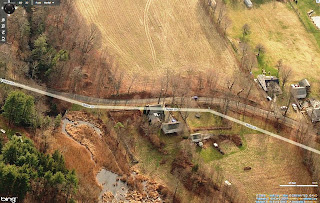At the Watertown Land Trust’s website ( http://www.watertownlandtrust.org/id23.html), you can read that:
“The area is rich in local history. According to Cothren’s History of Ancient Woodbury (1854), this region provided Native Americans excellent hunting, fishing, and gathering of plants...At the northeastern boundary of the property, headwaters of the…River flow beneath the old Skilton Road Bridge, a stone arch structure built entirely without mortar in the 1860s and now on the National Historic Register. Repaired by the town in 1985, the bridge now can be viewed only from below, due to Jersey barriers along the road. Nearby are two outstanding 18th and early 19th century houses, placed on the state historical places register in 1966. In the late 1800s Cleveland’s mill was located near a dam on the river a short distance from the bridge.”
That 18th century house, coincidently, is dated the same year, 1734, as the house my family presently lives in, which I believe is the year our house was completed.
(Editing in Nov. 2022, I'm less sure about the date of our house.)
I’ve written about my observations at these two posts: More Turtle Visions & Watertown CT . I would have to say that the important “visions” are the additions of some different “turtle-types” incorporated into these stone rows, casually and conveniently dismissed as colonial land clearing by those who insist Native People did not build stone constructions. I’d give them descriptive names of:
“Turtles with Legs Fully Extended Forward”
“Swimming Turtles.”
Another result of these observations is that numerous stone rows that I had dismissed as colonial constructions – stone fences – I now view as “Native American Stone Rows, as they contain these “turtle-types.” The number of “Indian Stone Rows” I believe I see has grown incredibly, as well as beginning to suspect that the earliest of colonial roads followed stone rows rather than being a result of road clearing, a sort of “chicken/egg” situation, if you will…






No comments:
Post a Comment